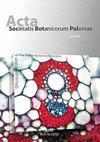Characterization and phylogenetic analysis of the complete mitochondrial genome of a unique economic plant <i>Lycium barbarum</i> L.
IF 0.8
4区 生物学
Q3 PLANT SCIENCES
引用次数: 0
Abstract
Lycium barbarum L. (L. barbarum), an important medicinal and food crop from the Solanaceae family, is known for excellent tolerance to saline–alkaline and drought stresses. Therefore, it has significant research and application value. The nuclear and chloroplast genomes of L. barbarum have been previously reported; however, its mitochondrial genome is still unexplored. In this study, mitochondrial DNA sequencing and assembly in L. barbarum were studied via second- and third-generation sequencing technologies using the anthers collected from the main cultivars “Ningqi No.1” (fertile line) and its male-sterile natural mutant “Ningqi No.5” from Ningxia, China. The results revealed that “Ningqi No.1” and “Ningqi No.5” have the same mitochondrial circular genome structure with a total length of 413,881 bp. In total, 61 genes were annotated, including 35 protein-coding genes, four rRNA genes, 22 tRNA genes, and 2,242 open reading frames with unknown functions. The repeat sequences in mtDNA were analyzed, in which short repeats (30–59 bp) exhibited the highest number. Overall, 23 protein-coding genes in “Ningqi No.1” and “Ningqi No.5” exhibited RNA-editing phenomenon, with different RNA-editing site number and distribution position. Phylogenetic analysis demonstrated that L. barbarum has the closest relationship with Hyoscyamus niger. These results provided a basis for a comprehensive understanding of the mitochondrial genome of L. barbarum and the relevant data for omics studies on L. barbarum.独特经济植物枸杞线粒体全基因组的鉴定与系统发育分析l
& lt; i>枸杞barbarum< / i>L . (& lt; i> L。巴巴拉姆(barbarum</i>)是茄科重要的药用和粮食作物,以耐盐碱和干旱胁迫而闻名。因此,具有重要的研究和应用价值。L的核基因组和叶绿体基因组。barbarum< / i>以前曾报道过;然而,它的线粒体基因组仍未被探索。在本研究中,线粒体DNA的测序和组装在<i>L。barbarum< / i>以宁夏主要栽培品种“宁七1号”(可育系)及其雄性不育自然突变体“宁七5号”的花药为材料,采用二代和三代测序技术进行了研究。结果表明,“宁七1号”与“宁七5号”线粒体环状基因组结构相同,总长度为413881 bp。共注释61个基因,包括35个蛋白质编码基因、4个rRNA基因、22个tRNA基因和2242个功能未知的开放阅读框。对mtDNA重复序列进行分析,发现短重复序列(30 ~ 59 bp)最多。总体而言,“宁七1号”和“宁七5号”的23个蛋白质编码基因表现出rna编辑现象,但rna编辑位点数量和分布位置不同。系统发育分析表明;barbarum< / i>与Hyoscyamus nig</i>关系最为密切。这些结果为全面了解<i>L线粒体基因组提供了基础。barbarum< / i>以及组学研究的相关数据。barbarum< / i>。
本文章由计算机程序翻译,如有差异,请以英文原文为准。
求助全文
约1分钟内获得全文
求助全文
来源期刊
CiteScore
2.00
自引率
10.00%
发文量
18
审稿时长
1 months
期刊介绍:
The journal has been published since 1923 and offers Open Access publication of original research papers, short communications, and reviews in all areas of plant science, including evolution, ecology, genetics, plant structure and development, physiology and biochemistry.

 求助内容:
求助内容: 应助结果提醒方式:
应助结果提醒方式:


